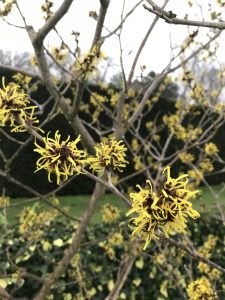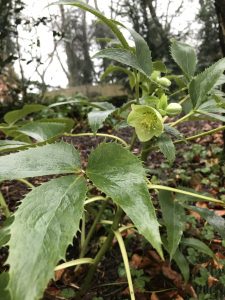Why I can’t get enough of Yew: Assessing your garden in winter

If looking out at your garden in winter is making you unhappy, it may be time to take stock of your seasonal selection. Gardens, especially more traditional English gardens, can be synonymous with flowers. But it is worth paying as much attention to structure and to selecting the right evergreen, leafy plants if you want to get year-round pleasure. This is a good time to replan, particularly if you have been thinking of a garden makeover. Rather than waiting until the garden is in full bloom, this season gives a chance to see the “bare bones” of your garden. Look at what you have now and consider buying and placing some winter favourites at strategic points, where they will catch your eye in these quieter months. This might mean removing some of your old stalwarts, but it is worth the effort. Then, once the new winter plants are in place, use them as a framework to build around: as the year goes on, fill in the gaps with your spring and summer blooms. This will ensure the garden offers longer term interest.
My Winter Collection
These are some of my winter favourites- a selection of trees, shrubs and herbaceous plants. They can be bought and planted now (as long as the ground is not frozen solid). While you may not get the full benefit this year, they will establish and be ready for you to enjoy next winter. It will also give you the framework to build around if you are then planning spring and summer planting.
Taxus baccata (Yew Tree): I can’t enthuse enough about Yew, as its short, dark needles, which are more flexible than many conifers, give great soft structure. It is easy to shape and really only needs cutting once a year. Small yews are wonderful in both formal and informal constructions. Larger ones can be maintained as impressive topiary shapes. Female yew trees will also yield red berries. The main picture above shows historic Yew topiary at Powis Castle.

Salix alba ‘Britzensis’ (Scarlet Willow): Rather than thinking of a large, weeping willow tree, think of this tree as giving a shock-head of winter colour. It is a variety of the native White Willow, which, when pollarded or hard pruned back to a low trunk each spring, will give a nest of brightly coloured new stems which stand out across the garden in winter. “Britzensis” is a good cultivar to choose for the orange/red colour in the new stems, though others are available which will give a more yellow growth.

Hammamelis mollis (Witch Hazel): An old favourite, and rightly so. Feathery yellow flowers burst forth from bare stems in mid to later winter, releasing a sweet smell. Other species of Hammamelis and a range of cultivars can be used to give differing shades or yellows or reds, and differing levels of scent.
Sarcocca confusa (Sweet Box): Sweet Box has it all – dark glossy foliage, and sweet wafts of scent from its tiny white flowers. A small patch will fill a corner of the garden with a sugary cloud. The flowers give way to small berries later in the season which will stay on the plant for some time. This plant grows as a dense bush around 1-1.5m high and prefers shade, so can bring life to a darker corner.
Cornus sanguinea (Dogwood): Cornus can be an attractive background shrub or hedgerow plant, but it is its bare winter stems which most people will recognise. After the leaves have dropped, the previous year’s growth becomes a stunning twiggy display. To maintain this, the plant, once left for 2 years to establish, should be cut back hard (either coppicing or pollarding) in early spring each year. “Midwinter Fire” is a popular cultivar which has gradated red-orange stems.
Euphorbia x martinii (Martin’s Spurge): Generally, Euphorbias won’t be in flower until later in the year, but they are a great foliage plant for the garden in winter. This one is a cross between Euphorbia amygdaloides and characias and echoes their characteristics with grey-green leaves on reddish stems. Again, there are exciting cultivars of Euphorbia martinii available, such as “Rudolph” which has red rosettes at the tips of the stems. They can actually be a bit overpowering in a border, but make a great dot plant in a winter pot.

Helleborus sps (Hellebores): Also known as the Christmas Rose, there are many cultivars of Helleborus x hybridus which will give pretty blooms in your garden at this time of year. They generally range from white through dusky pinks to near black and can be a bit “blousey” for some tastes. However whatever your view they will be a welcome addition at this time of year. I love their slightly tropical-looking tough, deep green palmate leaves (although it is best to cut the large, old leaves off in January to display the flowers). For something different, I love Helleborus argutifolius – a more upright, stalked plant with grey-green foliage and flowers held at the tops of the leaf stalks (so no need for a January prune).

Asplenium scolopendrium (Hart’s tongue fern): Although the tough, plasticy fronds of the Harts Tongue Fern will start to discolour and so it may need a trim at this time of year to take off the old stems, this remains my all time favourite filler for providing a natural look and year round pleasure.
Galanthus nivalis (Snowdrops): Nothing compares to the joy of seeing the first snowdrops emerge. You may be less aware of the numbers of species and cultivars of snowdrop available. The cultivar “S. Arnott”, a stalwart of the snowdrop world, will surprise with its larger size if you are used to seeing only common snowdrops.
Viola sps (Pansies): I am still getting pleasure from the Viola “Primrose Blotch” I bought in September, every time I step out of my door past my window box (which you can see here). I am also a sucker for Viola Sorbet White, which may seem like a rather boring choice, but dazzles with its pure white petals.